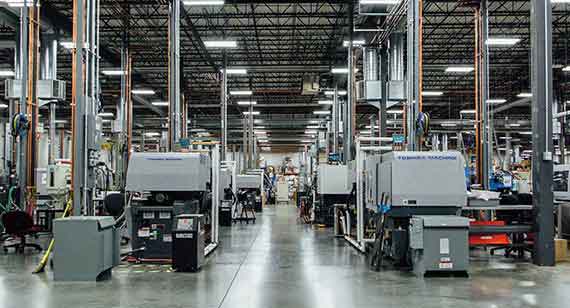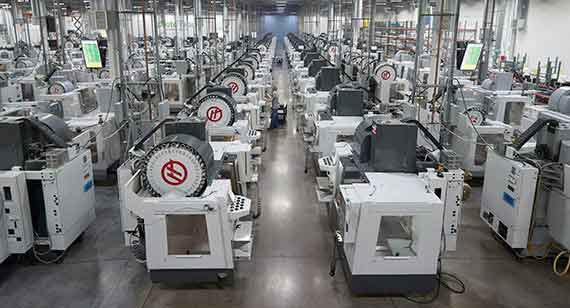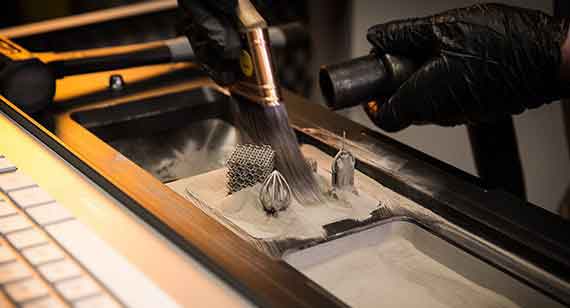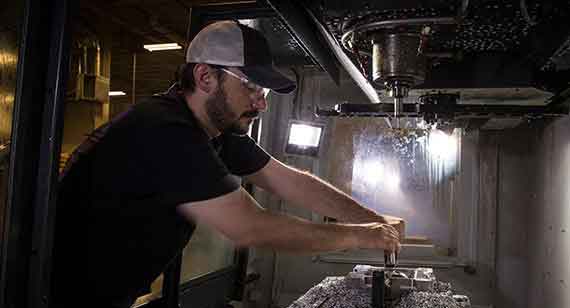Do You Know Who's Manufacturing Your Parts? Service Bureau vs. Broker
Working with a contract manufacturer is a relationship that’s often compared to marriage. In both cases, finding the right match is the key to a happily-ever-after outcome. As with matrimony, experts recommend focusing on compatibility before going down the aisle—make that placing an order—with a manufacturing supplier.

The search for that right match should focus on finding a supplier that’s a good fit with your product and its place in the market. The manufacturing processes, capacity, standards, turnaround time, and cost should meet your needs.
Before taking the plunge with a contract manufacturer, you may consider doing your project in-house. Prototyping or short-run production may work for companies that have internal R&D labs or small shops with desktop or industrial 3D printers, a CNC mill, or an injection molding press. In-house shops, while convenient, may fall short on producing more complex parts, often have limited capacity so they become backlogged, and may have a limited selection of materials.
To overcome those challenges, the ideal partner may be a service bureau, a knowledgeable manufacturing supplier of parts with a full suite of services. The best service bureaus will work with you all the way from design and prototyping to engineering builds and on-demand production over the life of your product—further optimizing your supply chain.
There are also companies that are considered brokers, outsourcing their orders to a network of other parts suppliers through a model better known as distributed manufacturing. This can provide you with more production options in some cases, however, working with a broker may add time and additional layers of communication as they bid out your project. Quality and consistency may be a concern as well since parts are being produced among different manufacturers versus a single manufacturer with an established set of quality regulations. In fact there is a high rate of variability machine shop to machine shop when considering capital equipment, process controls, quality standards, and more.
An independent machine shop is a smaller manufacturing alternative, typically specializing in a limited number of services. They also may run into capacity constraints because of their size or when large customers’ orders take precedence.

High-volume production houses are the answer when you need many thousands or millions of parts. Upfront engineering to ensure a smooth run will add cost, however, and they likely will be slower and more expensive for prototyping, short runs or low-volume production.
Questions to Consider
As you evaluate your options, ask yourself six important questions:
- Does the supplier have the manufacturing capabilities you need? See for yourself and visit the factory floor if possible.
- Does it have the manufacturing speed and capacity to respond to quick-turn orders during product development, market launch, or production phases?
- Does it have minimum part order? Many production houses have relatively large minimum part orders, which can be a risky upfront financial investment if only low volumes of parts are initially needed. Look for a service bureau with no minimum part restrictions.
- Does it have the level of quality control you need? A medical-grade supplier’s quality control should be excellent but that would add expense to a commercial-grade product that may not need an elevated level.
- Does it work with your project’s materials? Service bureaus typically stock with the widest selection of materials on hand and have the most expertise in using them. They often accept most customer-supplied materials as well.
- Does it offer design support? If you’re not a manufacturing expert, advice or feedback on the manufacturability of your project may be in order.
Those are some of the primary considerations that product development consultant Perry Parendo advises keeping in mind when evaluating prospective suppliers. Parendo, founder of Shenzhen-based Perry’s Solutions, has experience in the medical, automotive, aerospace, and defense industries.
For corporations, midsized companies, and others with the resources to assess a supplier’s capabilities, Parendo recommends working directly with a service bureau. For some smaller companies and those without such expertise, a broker may be the place to start.
When possible, Parendo said, he prefers taking projects directly to suppliers to streamline communications, avoid the expense of a broker, and maintain greater consistency and control.
“You’re trying to build long-term relationships with select, critical suppliers,” Parendo said. “With a broker you never know who they’ll go to next” among the broker’s supplier network.
Michael Corr, founder of Durolabs, a Los Angeles-based manufacturing consulting firm, said working with a broker can make things simpler “if your own Rolodex of suppliers is fairly shallow.” A broker or intermediary also can help overcome language and cultural barriers reducing the risk in dealing with overseas suppliers.
“You might lose a day because you have to send engineering notes to the translator and then they have to translate it and send it to a Chinese supplier, and then the reciprocal,” said Corr, whose experience includes working in China with contract manufacturers and suppliers. “But losing a day in order to save, say, three weeks because a part has to be redone because of miscommunication is worth it.”
Working directly with manufacturing suppliers, however, is the best way to avoid delays and mistakes arising from miscommunication, and to get feedback that will improve your current project and future ones.
“Manufacturing is all about relationships with suppliers at the technical level and the personal level,” Corr said. “It’s all about what you can do to remove any potential ambiguity or misinterpretation because the risks are too high, too expensive both in time and money.
He added, “I personally never use brokers. I learn so much more by talking directly to the supplier about what they need. It makes me better as an engineer so that the next time I work with them or another supplier I will have direct experience about what they expect.”
Here is a closer look at five options for choosing a manufacturing supplier:
1. Service Bureaus
Service bureaus typically have a wide choice of manufacturing technologies, with the best offering a full suite of services such as injection molding, CNC machining, or 3D printing. In addition, these bureaus often provide online automated quoting, and valuable design-for-manufacturability analysis. Higher-value service bureaus will have the ability to work with you throughout the design and development process as well as the entire life of your product. Service bureaus typically have a deep knowledge of how to make the best use of their processes and materials.
Quality control: Consistency is a strong suit. They typically have better control plans, inspection reports, and processes to ensure repeatability and reliability.
Turnaround time: Should be extremely responsive, with better results from those with the ability to respond immediately to your order.
Volume: Varies, depending on capacity. A small service bureau may hold little volume advantage over an internal shop.
Production cost: Varies but may be higher than some internal shops. Service bureaus, however, know the competitive landscape and price accordingly. Prices at larger bureaus fluctuate less than at smaller ones, which tend to drop prices when they need work and raise them when they’re busy.
2. Service Brokers
A broker can help companies, especially smaller ones, that don’t have the resources to evaluate suppliers. Brokers have an incentive to find the right fit between their client and the outsourcing partner in terms of manufacturing capabilities, quality control, or certifications. Find out a broker’s sweet spot and determine whether it aligns with your project. A broker specializing in automotive prototypes, for example, might not be the right choice for your ISO 13485 medical device.
Quality control: Consistency is a potential problem because subsequent orders may go to different service bureaus. You may get exactly what you want one time but not the next.
Turnaround time: Varies based on the size of the broker’s network and the capacity of the suppliers within it. Delays are inherent as the broker bids out the project.
Volume: Also depends on the size of the broker’s network. If their usual bureaus are busy, your project may go to a lesser-known supplier.
Production cost: The broker’s practice of bidding jobs out may offer some savings. But using a broker adds cost.

There are also companies that are considered brokers, outsourcing their orders to a network of other parts suppliers through a model better known as distributed manufacturing. This can provide you with more production options in some cases, however, working with a broker may add time and additional layers of communication as they bid out your project. Quality and consistency may be a concern as well since parts are being produced among different manufacturers versus a single manufacturer with an established set of quality regulations. In fact there is a high rate of variability machine shop to machine shop when considering capital equipment, process controls, quality standards, and more.
An independent machine shop is a smaller manufacturing alternative, typically specializing in a limited number of services. They also may run into capacity constraints because of their size or when large customers’ orders take precedence.

3. Independent Machine Shops
These suppliers typically are smaller and more specialized. Some may be good at working with challenging materials like Inconel, but may be more expensive for basic aluminum parts. Machine shops may be among the best at their core expertise but not in others.
Quality control: Ranges across suppliers and usually depends on their niche or expertise. Quality control at machine shop specializing in aerospace or ISO 13485 medical devices should be excellent and should still be good but less formalized at “garage shops.”
Turnaround time: Should be fast and competitive when they have capacity but subject to backups when busy.
Volume: Because they tend to be smaller, machine shops may have capacity constraints. If your project is in the shop’s core service, it should have greater capacity for that than for other jobs.
Production cost: Shops specializing in parts for the aerospace industry, for example, or those working with exotic materials or parts with tight tolerance typically will be more expensive because of the higher-end machines required.
4. High-Volume Production Houses
High-volume production houses, typically focused on injection molding and CNC machining, reduce piece part price when running thousands or millions of parts. Their niche is shaving seconds and pennies off of projects through high-speed repetition, especially when running “lights out” or in a factory that’s fully automated. Upfront engineering expenses may be high. These suppliers typically don’t like doing prototypes because they’re not cost effective at it.
Quality control: Typically very good. Production houses specializing in highly regulated industries typically will meet the required standard. Quality control for commodity-type parts will be at a lower but appropriate level.
Turnaround time: Typically good and predictable for high volumes. Delays may result if the supplier has to acquire equipment to produce your part, which many will do.
Volume: Large orders are their bread and butter. Will dedicate equipment to a project, such as a molding cell that would run parts for years at a time.
Production cost: The higher the volume, the better the cost because of the focus on operating efficiently. If you need just a few dozen or a couple hundred parts, however, they’re more expensive.
5. In-House Production
In-house production offers the prospect of convenience—just walk down the hall to get a part made. A desktop or industrial-grade 3D printer can make a concept model of a product or parts for form and fit testing. An in-house shop with an industrial 3D printer, CNC machine, or molding press can provide engineering-grade parts that are production representatives. That convenience comes at a cost, however, from the upfront capital investment in equipment and acquiring and storing materials to having skilled who can operate the machines effectively. And that convenience is available only when an internal shophas capacity. They regularly partner with service bureaus for quicker, simpler production parts or functional prototypes.
Quality control: Typically very good but likely sporadic in an early R&D shop and better when a part is transitioning to production.
Turnaround time: In-house shops often operate at or near capacity, leading to long lead times that force development teams to outsource to get parts made quickly.
Volume: Typically work in lower volume because of limited capacity and specialization.
Production cost: Larger OEMs often have a friendly cost structure that doesn’t apply costs to individual projects. OEMs and in-house shops can be more expensive when manufacturing parts outside their forte.